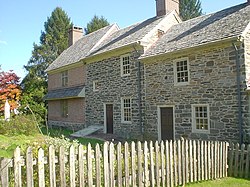Thomas Massey House
|
1696 Thomas Massey House
|
|

Thomas Massey House, October 2009
|
|
| Location | Lawrence and Springhouse Rds., Broomall, Pennsylvania |
|---|---|
| Coordinates | 39°57′55″N 75°21′5″W / 39.96528°N 75.35139°WCoordinates: 39°57′55″N 75°21′5″W / 39.96528°N 75.35139°W |
| Area | 1 acre (0.40 ha) |
| Built | 1696 |
| Architect | Thomas Massey |
| Architectural style | Colonial |
| NRHP Reference # | 70000904 |
| Significant dates | |
| Added to NRHP | November 16, 1970 |
| Designated PHMC | May 09, 1986 |
The 1696 Thomas Massey House is one of the oldest English Quaker homes in the Commonwealth of Pennsylvania. It is a 2-story brick and stone house, originally constructed by the English, Quaker settler, Thomas Massey in 1696. It is located on Lawrence Road near Sproul Road in Broomall, Pennsylvania.
Thomas Massey was born in the village of Marpoole (Marple) in Cheshire, England. He was a Quaker and an indentured servant to Francis Stanfield, who arranged for him and seven other indentured servants to emigrate to America. Thomas set sail from Chester, England aboard the ketch "Endeavor". He landed in Philadelphia, PA on September 29, 1683 at the age of twenty. After Thomas worked off his indenture, he received 50 acres (20 ha) of land from his master and another 50 acres from William Penn. In 1692, at age 29, he married 22-year-old Phebe Taylor, who had arrived on the same ship as Massey. Together they had seven children: Esther (1693), Mordecai (1695), James (1697), Hannah (1699), Thomas (1701), Phoebe (1705) and Mary (1707) Thomas died in 1707 or 1708 and Phebe remarried two years later. His oldest son, Mordecai, inherited the house. It was owned by the Massey family until 1925.
Thomas Massey built the original brick section in 1696 as an addition to an earlier wooden house. Thomas's son Mordecai Massey likely tore down the wooden house and built the first stone addition during the 1730s. A stone walled kitchen was added in the early nineteenth century with a second story above the kitchen added about 1860.
The house remained in the Massey family until 1925, and was used as a farmhouse into the 1930s when a furnace and electrical wiring were added. When the land around the house was developed into suburban housing, the Massey House was used for storage and painting.
In 1964, the house was saved from demolition by Massey's descendant, Lawrence M.C. Smith. Smith bought the house and 1-acre (0.40 ha) of ground and donated the property to Marple Township on condition that it be restored within ten years. The restoration was completed by architect, John Milner. During the restoration, a walk-in-fireplace and beehive oven were uncovered. Many of the home's original features have been restored and are fully functional.
...
Wikipedia


